Kenwood USA 443801 UHF Digital Transceiver User Manual Instructional Manual
Kenwood USA Corporation UHF Digital Transceiver Instructional Manual
Instructional Manual
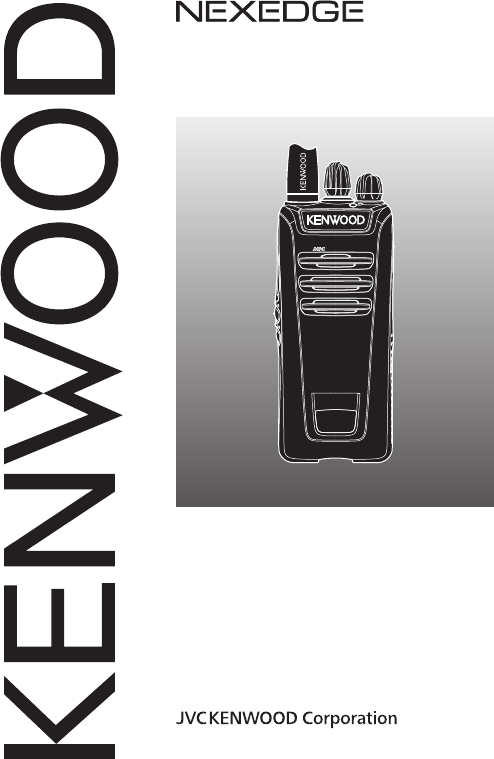
NX-240 NX-240V
NX-340 NX-340U
© B62-2580-00 (K, P)
09 08 07 06 05 04 03 02 01 00
VHF DIGITAL TRANSCEIVER
UHF DIGITAL TRANSCEIVER
INSTRUCTION MANUAL
ÉMETTEUR-RÉCEPTEUR NUMÉRIQUE VHF
ÉMETTEUR-RÉCEPTEUR NUMÉRIQUE UHF
MODE D’EMPLOI
TRANSCEPTOR DIGITAL VHF
TRANSCEPTOR DIGITAL UHF
MANUAL DE INSTRUCCIONES
B62-2580-00_Cover.indd 1 7/5/13 1:51 PM
B62-2580-00_Cover.indd 2 7/5/13 1:51 PM

VHF DIGITAL TRANSCEIVER
UHF DIGITAL TRANSCEIVER
NX-240 NX-240V
NX-340 NX-340U
INSTRUCTION MANUAL
ENGLISH
B62-2580-00_Cover.indd 3 7/5/13 1:51 PM

THANK YOU
We are grateful you have chosen KENWOOD for your land
mobile radio applications.
NOTICES TO THE USER
◆ Government law prohibits the operation of unlicensed radio
transmitters within the territories under government control.
◆ Illegaloperationispunishablebyneand/orimprisonment.
◆ Referservicetoqualiedtechniciansonly.
Safety: It is important that the operator is aware of, and
understands, hazards common to the operation of any
transceiver.
Terminal Descriptions
Speaker/ Microphone Jacks
Itispossibletousearesin-basedcoverfortheSpeaker/Microphonejacks.
No. Name Description Impedance I/O
1PTT/RXD ExternalPTTInput/SerialDataInput 47kΩ I
2MICIN ExternalMICInput 1.8kΩ I
3MICO InternalMICOutput 1.8kΩ O
4OPTDET ExternalOptionDetect High Impedance I
5 50V 5VOutput 100Ω O
6 AE GND GND −
7TXD SerialDataOutput 6.9kΩ O
8NC NoConnection −−
9NC NoConnection −−
10 SPO ReceivedAudioOutput 8Ω O
Antenna Terminal
50Ωimpedance
Battery Terminal
The battery terminal uses a spring plate.
The negative terminal connects to the chassis ground.
The battery is mounted on the rear side of the transceiver using a latch
mounting method.
B62-2580-00_000.indd 1 7/5/13 1:55 PM

i
One or more of the following statements may be
applicable:
FCC WARNING
This equipment generates or uses radio frequency energy. Changes
or modications to this equipment may cause harmful interference
unless the modications are expressly approved in the instruction
manual. The user could lose the authority to operate this equipment
if an unauthorized change or modication is made.
INFORMATION TO THE DIGITAL DEVICE USER REQUIRED BY
THE FCC
This equipment has been tested and found to comply with the limits
for a Class B digital device, pursuant to Part 15 of the FCC Rules.
These limits are designed to provide reasonable protection against
harmful interference in a residential installation.
This equipment generates, uses and can generate radio frequency
energy and, if not installed and used in accordance with the
instructions, may cause harmful interference to radio communications.
However, there is no guarantee that the interference will not occur
in a particular installation. If this equipment does cause harmful
interference to radio or television reception, which can be determined
by turning the equipment off and on, the user is encouraged to try to
correct the interference by one or more of the following measures:
• Reorient or relocate the receiving antenna.
• Increase the separation between the equipment and receiver.
• Connect the equipment to an outlet on a circuit different from
that to which the receiver is connected.
• Consult the dealer for technical assistance.
B62-2580-00_0i-vi.indd 1 7/5/13 1:56 PM

ii
PRECAUTIONS
• Do not charge the transceiver and battery pack when they are
wet.
• Ensure that there are no metallic items located between the
transceiver and the battery pack.
• Do not use options not specied by KENWOOD.
• If the die-cast chassis or other transceiver part is damaged, do
not touch the damaged parts.
• If a headset or headphone is connected to the transceiver,
reduce the transceiver volume. Pay attention to the volume
level when turning the squelch off.
• Do not place the microphone cable around your neck while near
machinery that may catch the cable.
• Do not place the transceiver on unstable surfaces.
• Ensure that the end of the antenna does not touch your eyes.
• When the transceiver is used for transmission for many hours,
the radiator and chassis will become hot. Do not touch these
locations when replacing the battery pack.
• Do not immerse the transceiver in water.
• Always switch the transceiver power off before installing
optional accessories.
• The charger is the device that disconnects the unit from the AC
mains line. The AC plug should be readily accessible.
ATTENTION:
The RBRC Recycle seal found on KENWOOD lithium-
ion (Li-ion) battery packs indicates KENWOOD’s
voluntary participation in an industry program to collect
and recycle Li-ion batteries after their operating life
has expired. The RBRC program is an alternative to
disposing Li-ion batteries with your regular refuse or in
municipal waste streams, which is illegal in some areas.
For information on Li-ion battery recycling in your area, call (toll free)
1-800-8-BATTERY (1-800-822-8837).
KENWOOD’s involvement in this program is part of our commitment to
preserve our environment and conserve our natural resources.
B62-2580-00_0i-vi.indd 2 7/5/13 1:56 PM

iii
Turn the transceiver power off in the following locations:
• In explosive atmospheres (inammable gas, dust particles, metallic
powders, grain powders, etc.).
• While taking on fuel or while parked at gasoline service stations.
• Near explosives or blasting sites.
• In aircraft. (Any use of the transceiver must follow the instructions
and regulations provided by the airline crew.)
• Where restrictions or warnings are posted regarding the use of
radio devices, including but not limited to medical facilities.
• Near persons using pacemakers.
• Do not disassemble or modify the transceiver for any reason.
• Do not place the transceiver on or near airbag equipment while the
vehicle is running. When the airbag inates, the transceiver may
be ejected and strike the driver or passengers.
• Do not transmit while touching the antenna terminal or if
any metallic parts are exposed from the antenna covering.
Transmitting at such a time may result in a high-frequency burn.
• If an abnormal odor or smoke is detected coming from the
transceiver, switch the transceiver power off immediately,
remove the battery pack from the transceiver, and contact your
KENWOOD dealer.
• Use of the transceiver while you are driving may be against trafc
laws. Please check and observe the vehicle regulations in your
area.
• Do not expose the transceiver to extremely hot or cold conditions.
• Do not carry the battery pack (or battery case) with metal objects,
as they may short the battery terminals.
• When operating the transceiver in areas where the air is dry, it is
easy to build up an electric charge (static electricity). When using
an earphone accessory in such conditions, it is possible for the
transceiver to send an electric shock through the earphone and to
your ear. We recommend you use only a speaker/microphone in
these conditions, to avoid electric shocks.
B62-2580-00_0i-vi.indd 3 7/5/13 1:56 PM

iv
Information concerning the battery pack:
The battery pack includes ammable objects such as organic
solvent. Mishandling may cause the battery to rupture
producing ames or extreme heat, deteriorate, or cause other
forms of damage to the battery. Please observe the following
prohibitive matters.
• Do not disassemble or reconstruct battery!
The battery pack has a safety function and protection circuit to
avoid danger. If they suffer serious damage, the battery may
generate heat or smoke, rupture, or burst into ame.
• Do not short-circuit the battery!
Do not join the + and – terminals using any form of metal (such
as a paper clip or wire). Do not carry or store the battery pack in
containers holding metal objects (such as wires, chain-necklaces or
hairpins). If the battery pack is short-circuited, excessive current will
ow and the battery may generate heat or smoke, rupture, or burst
into ame. It will also cause metal objects to heat up.
• Do not incinerate or apply heat to the battery!
If the insulator is melted, the gas release vent or safety function is
damaged, or the electrolyte is ignited, the battery may generate
heat or smoke, rupture, or burst into ame.
• Do not leave the battery near re, stoves, or other heat
generators (areas reaching over 80°C/ 176°F)!
If the polymer separator is melted due to high temperature, an
internal short-circuit may occur in the individual cells and the
battery may generate heat or smoke, rupture, or burst into ame.
• Do not immerse the battery in water or get it wet by other
means!
If the battery’s protection circuit is damaged, the battery may
charge at extreme current (or voltage) and an abnormal chemical
reaction may occur. The battery may generate heat or smoke,
rupture, or burst into ame.
• Do not charge the battery near re or under direct sunlight!
If the battery’s protection circuit is damaged, the battery may
charge at extreme current (or voltage) and an abnormal chemical
reaction may occur. The battery may generate heat or smoke,
rupture, or burst into ame.
B62-2580-00_0i-vi.indd 4 7/5/13 1:56 PM

v
• Use only the specied charger and observe charging
requirements!
If the battery is charged in unspecied conditions (under high
temperature over the regulated value, excessive high voltage or
current over regulated value, or with a remodeled charger), it may
overcharge or an abnormal chemical reaction may occur. The
battery may generate heat or smoke, rupture, or burst into ame.
• Do not pierce the battery with any object, strike it with an
instrument, or step on it!
This may break or deform the battery, causing a short-circuit. The
battery may generate heat or smoke, rupture, or burst into ame.
• Do not jar or throw the battery!
An impact may cause the battery to leak, generate heat or smoke,
rupture, and/or burst into ame. If the battery’s protection circuit
is damaged, the battery may charge at an abnormal current (or
voltage), and an abnormal chemical reaction may occur. The
battery may generate heat or smoke, rupture, or burst into ame.
• Do not use the battery pack if it is damaged in any way!
The battery may generate heat or smoke, rupture, or burst into
ame.
• Do not solder directly onto the battery!
If the insulator is melted or the gas release vent or safety function
is damaged, the battery may generate heat or smoke, rupture, or
burst into ame.
• Do not reverse the battery polarity (and terminals)!
When charging a reversed battery, an abnormal chemical reaction
may occur. In some cases, an unexpected large amount of current
may ow upon discharging. The battery may generate heat or
smoke, rupture, or burst into ame.
• Do not reverse-charge or reverse-connect the battery!
The battery pack has positive and negative poles. If the battery
pack does not smoothly connect with a charger or operating
equipment, do not force it; check the polarity of the battery. If the
battery pack is reverse-connected to the charger, it will be reverse-
charged and an abnormal chemical reaction may occur. The
battery may generate heat or smoke, rupture, or burst into ame.
B62-2580-00_0i-vi.indd 5 7/5/13 1:56 PM
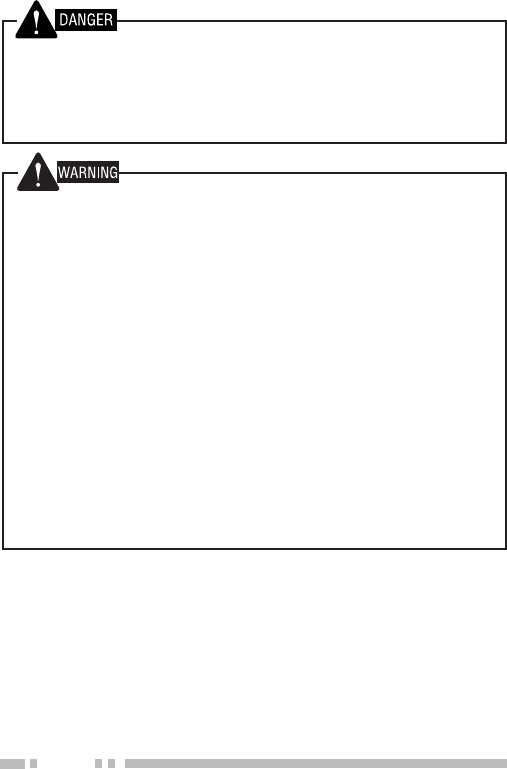
vi
• Do not touch a ruptured and leaking battery!
If the electrolyte liquid from the battery gets into your eyes, wash
your eyes with fresh water as soon as possible, without rubbing
your eyes. Go to the hospital immediately. If left untreated, it may
cause eye-problems.
• Do not charge the battery for longer than the specied time!
If the battery pack has not nished charging even after the
regulated time has passed, stop it. The battery may generate heat
or smoke, rupture, or burst into ame.
• Do not place the battery pack into a microwave or high
pressure container!
The battery may generate heat or smoke, rupture, or burst into
ame.
• Keep ruptured and leaking battery packs away from re!
If the battery pack is leaking (or the battery emits a bad odor),
immediately remove it from ammable areas. Electrolyte leaking
from battery can easily catch on re and may cause the battery to
generate smoke or burst into ame.
• Do not use an abnormal battery!
If the battery pack emits a bad odor, appears to have different
coloring, is deformed, or seems abnormal for any other reason,
remove it from the charger or operating equipment and do not use
it. The battery may generate heat or smoke, rupture, or burst into
ame.
B62-2580-00_0i-vi.indd 6 7/5/13 1:56 PM
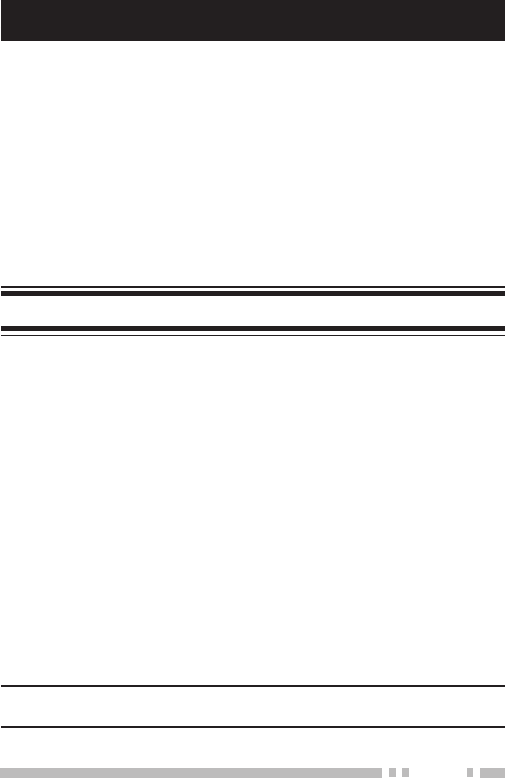
1
CONTENTS
UNPACKING AND CHECKING EQUIPMENT ..................1
PREPARATION ..................................................................2
ORIENTATION ...................................................................7
PROGRAMMABLE AUXILIARY FUNCTIONS .................. 8
BASIC OPERATIONS ...................................................... 11
VOICE OPERATED TRANSMISSION (VOX) ..................14
NXDN ...............................................................................15
BACKGROUND OPERATIONS ......................................16
UNPACKING AND CHECKING EQUIPMENT
Carefully unpack the transceiver. If any of the items listed
below are missing or damaged, le a claim with the carrier
immediately.
SUPPLIED ACCESSORIES
• Antenna ..................................................................................1
• Battery charger/ AC adapter ...................................................1
K type: KSC-35S
P type: KSC-43
• Li-ion Battery pack (KNB-45L) ................................................1
• Speaker/ microphone jack cover ............................................1
• Speaker/ microphone locking bracket ....................................1
• Belt clip (KBH-10) ...................................................................1
• Screw (M3 x 8 mm) ................................................................2
• Channel stopper .....................................................................1
• Instruction manual ..................................................................1
Note: Refer to “PREPARATION” starting on page 2 for accessory
installation instructions.
B62-2580-00_01-18.indd 1 7/5/13 1:56 PM

2
PREPARATION
INSTALLING THE CHANNEL STOPPER
You can set the channel stopper position for channels 2, 4,
6, 8, 10, 12, and 14. Inserting the Channel stopper prevents
unnecessarily selecting channels which do not exist.
• Selecting a channel which does not exist causes a continuous
error tone to sound.
1 Set the Channel selector to channel 1, then pull the
Channel selector knob off the transceiver.
• If the Channel selector is not positioned at channel 1, the knob
may not install correctly and the channel may be unable to change.
2 Insert the channel stopper.
3 Set the arrow of the Channel stopper to the highest channel
number for the transceiver.
4 Reinsert the Channel selector knob.
Screw the antenna into the connector on the
top of the transceiver by holding the antenna at
its base and turning it clockwise until secure.
Note: The antenna is neither a handle, a
key ring retainer, nor a speaker/ microphone
attachment point. Using the antenna in these
ways may damage the antenna and degrade your
transceiver’s performance.
INSTALLING THE ANTENNA
Channel stopper
Arrow
Antenna
B62-2580-00_01-18.indd 2 7/5/13 1:56 PM

3
INSTALLING/ REMOVING THE BATTERY PACK
◆ Do not short the battery terminals or dispose of the battery by re.
◆ Never attempt to remove the casing from the battery pack.
1 Align the battery pack with the back
of the transceiver, then press the
battery pack and transceiver rmly
together until the release latch on
the base of the transceiver locks.
2 To remove the battery pack, lift the
safety catch on the base of the
transceiver, then press the release
latch underneath the safety catch.
3 While pressing the release latch,
pull the battery pack away from the
transceiver.
INSTALLING THE BELT CLIP
Do not use glue which is designed to prevent screw loosening when
installing the belt clip, as it may cause damage to the transceiver. Acrylic
ester, which is contained in these glues, may crack the transceiver’s
back panel.
Belt clip
If necessary, attach the belt clip using
the two supplied M3 x 8 mm screws.
Note: If the belt clip is not installed, its
mounting location may get hot during
continuous transmission or when left
sitting in a hot environment.
B62-2580-00_01-18.indd 3 7/5/13 1:56 PM
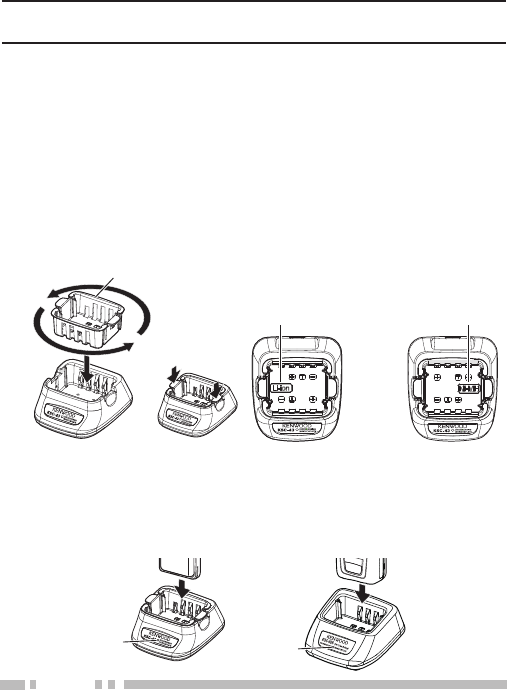
4
CHARGING THE BATTERY PACK
The battery pack is not charged at the factory; charge it before
use.
ATTENTION: Always switch OFF a transceiver equipped with a
battery pack before inserting the transceiver into the charger.
1 Plug the AC adapter cable into the jack located on the rear
of the charger.
2 Plug the AC adapter into an AC outlet.
3 KSC-43 Only: Match the holder to the type of battery pack
to be charged so that when inserting the holder, the battery
type name can be seen on the bottom of the charger. After
inserting the holder into the charger, press the locking tabs
to secure it in place.
• To remove the holder, squeeze the locking tabs together then
pull the holder out of the charger.
Holder
Li-ion battery
charger Ni-MH battery
charger
4 Slide a battery pack or a transceiver equipped with a
battery pack into the charging slot of the charger.
• Make sure the metal contacts of the battery pack mate
securely with the charger terminals.
• The indicator lights red and charging begins.
Indicator
Indicator
B62-2580-00_01-18.indd 4 7/5/13 1:56 PM

5
5 When charging is completed, the indicator lights green.
Remove the battery pack or the transceiver from the
charging slot of the charger.
• It takes approximately 3 hours to charge the battery pack.
• When the charger will not be used for a long time, unplug the
AC adapter from the AC outlet.
Note:
◆ When the indicator blinks red, the battery pack is either defective or
the battery pack contacts are not properly mated with those of the
charger.
◆ When the indicator ashes green and orange, the battery pack
has not satised the charging start temperature. Remove the
battery pack from the charger and wait until it reaches a normal
temperature before charging it again.
◆ The ambient temperature should be between 41°F and 104°F (5°C
and 40°C) while charging is in progress. Charging outside this range
may not fully charge the battery.
◆ The battery pack life is over when its operating time decreases even
though it is fully and correctly charged. Replace the battery pack.
INSTALLING THE CAP OVER THE SPEAKER/
MICROPHONE JACKS
Install the cap over the speaker/ microphone jacks when not
using an optional speaker/ microphone.
Note: To keep the transceiver water resistant, you must cover the
speaker/ microphone jacks with the supplied cap.
1 Place the cap over the jacks so that the locking tabs
insert into the transceiver grooves.
2 While holding the cap in place, push it towards the
bottom of the transceiver until the tabs on the cap click
into place.
• To remove the cap, hold the top of the cap in place
with your nger while inserting a 2 mm or smaller
at blade screwdriver under the bottom of the cap.
Slowly slide the screwdriver in until its tip touches
the tab inside the cap, then gently pry the cap
up (handle of screwdriver moving away from the
transceiver) to remove the cap.
B62-2580-00_01-18.indd 5 7/5/13 1:56 PM
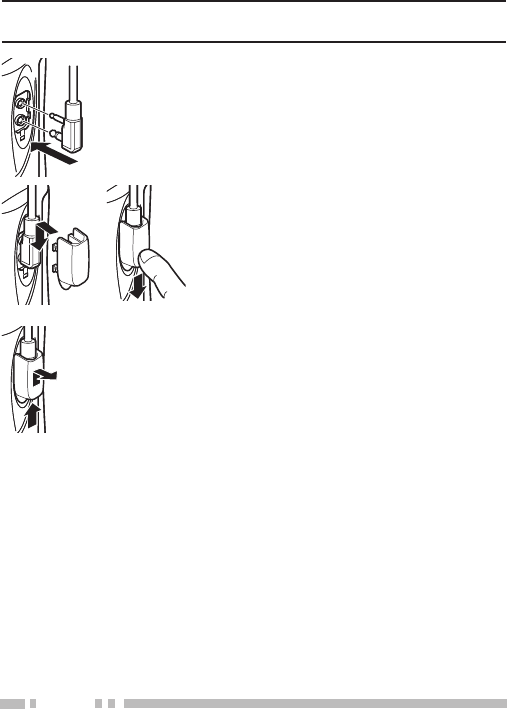
6
INSTALLING THE OPTIONAL SPEAKER/ MICROPHONE
(OR HEADSET)
Note: The transceiver is not fully water resistant when using a
speaker/ microphone or headset.
1 Insert the speaker/ microphone (or
headset) plugs into the speaker/
microphone jacks of the transceiver.
2 Place the locking bracket over the
speaker/ microphone (or headset) plugs
so that the locking tabs insert into the
transceiver grooves.
• Push down on the locking bracket to
slide it into place.
3 While holding the locking bracket in
place, push it towards the bottom of the
transceiver until the tabs on the bracket
click into place.
• To remove the locking bracket, push
the bracket up from the base.
B62-2580-00_01-18.indd 6 7/5/13 1:56 PM

7
ORIENTATION
① Channel selector
Rotate to change the operating channel.
② LED indicator
For the LED indicator status, refer to page 13.
③ Power switch/ Volume control
Turn clockwise to switch ON the transceiver. To switch OFF
the transceiver, turn counterclockwise until a click sounds.
Rotate to adjust the volume level.
④ PTT (Push to Talk) switch
Press and hold, then speak into the microphone to transmit.
⑤ Side 1 key
Press to activate its programmable function {page 8}.
⑥ Side 2 key
Press to activate its programmable function {page 8}.
⑦ Speaker/ microphone jacks
Insert the Speaker/ microphone or Headset plug into this jack
{page 6}.
Battery pack
Antenna
Microphone Speaker
B62-2580-00_01-18.indd 7 7/5/13 1:56 PM

8
PROGRAMMABLE AUXILIARY FUNCTIONS
Your dealer can program the Side 1 and Side 2 keys each with
one of the functions listed below.
Note: The duration of pressing a key to activate a function is
dependent on your dealer setting. Your dealer may have set
some keys to be held down for a short duration instead of being
momentarily pressed. Ask your dealer for details on which keys
need to be held down to activate their functions.
■ None
No function has been programmed.
■ Autodial
1
Autodial allows you to make a private DTMF call to another
party.
■ Call 1/ Call 2
Press to send a FleetSync status, NXDN status, or 2-tone
signaling call.
■ Calling Alert 1
A calling alert tone allows you to alert party members that
you are making a call. When making a call, rst hold down
this key.
• While holding down the key, the calling alert tone will sound.
Release the key to end the tone, then hold down the PTT
switch and speak into the microphone to transmit.
■ CW Message 2
Press to transmit the preset Morse code message on your
current channel.
■ Emergency
Press and hold to enter (or exit) Emergency mode.
■ Key Lock
Press to lock/unlock the transceiver keys. Without Status
Memory, when the transceiver power is turned OFF and
then ON again, the Key Lock function will be cancelled.
B62-2580-00_01-18.indd 8 7/5/13 1:56 PM

9
■ Key Lock with Status Memory
This operates the same as Key Lock except that when the
transceiver power is turned OFF and then ON again, the
keys remains locked.
■ Lone Worker
Lone Worker Mode is a safety feature built into the
transceiver. If the transceiver is not operated for a
pre-programmed period of time, the transceiver will emit a
tone and automatically enter Emergency operation. Press
this key to toggle the Lone Worker function ON or OFF.
■ Low Transmit Power
Each channel is programmed with either high or low
transmit power. On high transmit power channels, press
this key to change the transmit power to low power (you
cannot change low transmit power channels to use high
power).
■ Monitor
Press to deactivate signaling (QT/DQT, FleetSync
signaling, NXDN, etc.). Press this key again to return to
normal operation.
■ Monitor Momentary
Continuously hold down this key to deactivate signaling
(QT/DQT, FleetSync signaling, NXDN, etc.). Release this
key to return to normal operation.
■ Paging Call
Press to send a FleetSync or NXDN paging call to an ID
from the ID list.
■ Priority Zone-Channel Select
If the scan priority type is “Operator Selectable”, press
this key in normal mode to set the current channel as the
Priority channel.
■ Scan
Press to start (or stop) scanning the transceiver channels.
B62-2580-00_01-18.indd 9 7/5/13 1:56 PM

10
■ Scan Temporary Delete
When scan pauses at an undesired channel, you can
remove that channel from the scanning sequence by
pressing or holding this key.
■ Scrambler/Encryption
The Scrambler (analog) and Encryption (NXDN) function
allows you to hold a conversation in complete privacy.
When activated, any other party listening in on your
channel will be unable to understand your conversation.
Press this key to toggle the Scrambler/Encryption function
ON or OFF.
■ Send the GPS data
With the KMC-48GPS unit is connected, you can press this
key to send your positioning data to the base station.
■ Squelch Off 1
Press to hear background noise. Press this key again to
return to normal operation.
■ Squelch Off Momentary 1
Continuously hold down this key to hear background noise.
Release this key to return to normal operation.
■ Talk Around
The Talk Around function allows you to communicate
directly with other transceivers, without the use of a
repeater. Press this key to toggle the Talk Around function
ON or OFF.
■ Zone Down
Press to select the next zone.
■ Zone Up
Press to select the previous zone.
1 Available only for Analog operation.
2 Available only for NXDN operation.
B62-2580-00_01-18.indd 10 7/5/13 1:56 PM

11
BASIC OPERATIONS
SWITCHING POWER ON/OFF
Turn the Power switch/ Volume control clockwise to switch the
transceiver ON.
Turn the Power switch/ Volume control counterclockwise fully
to switch the transceiver OFF.
■ Transceiver Password
If your transceiver is password protected, the LED will light
blue when you turn the transceiver ON. Enter the password
(up to 4 digits) using the following procedure.
1 Set the Channel selector to position “1”.
2 Press the Side 1 or Side 2 key to enter the rst digit.
• The Side 1 key increases the digit value and the Side 2
key decreases it. The transceiver announces the digit
number as it changes.
3 Repeat step 2 for Channel selector positions 2 ~ 4.
• If there are less than 4 password digits, repeat for only the
number of digits the password contains.
4 Press the PTT switch to conrm the password.
• When the correct password is entered, the Blue LED turns
off.
ADJUSTING THE VOLUME
Rotate the Power switch/ Volume control to adjust the volume.
Clockwise increases the volume and counterclockwise
decreases it.
B62-2580-00_01-18.indd 11 7/5/13 1:56 PM

12
SELECTING A ZONE AND CHANNEL
1 Select the desired zone using the key programmed as
[Zone Up] or [Zone Down].
• Each zone contains a group of channels.
2 Select the desired channel using the Channel selector.
• Each channel is programmed with settings for transmitting and
receiving.
TRANSMITTING
1 Select the desired zone and channel.
2 Press the key programmed as [Monitor] or [Squelch Off]
to check whether or not the channel is free.
• If the channel is busy, wait until it becomes free.
3 Press the PTT switch and speak into the microphone.
Release the PTT switch to receive.
• For best sound quality, hold the transceiver approximately
1.5 inches (3 ~ 4 cm) from your mouth.
RECEIVING
Select the desired zone and channel. If signaling has been
programmed on the selected channel, you will hear a call only
if the received signal matches your transceiver settings.
Note: Signaling allows your transceiver to code your calls. This will
prevent you from listening to unwanted calls. Refer to “SIGNALING”
on page 17 for details.
B62-2580-00_01-18.indd 12 7/5/13 1:56 PM

13
LED INDICATOR STATUS
Indicator Color Meaning
Lights red Transmitting
Lights green Receiving a call
Blinks red Battery power is low while transmitting
Blinks green Scanning
Blinks orange
or blue * Receiving an encoded call (FleetSync
signaling, etc.)
Blinks red/orange The selected channel has not been
programmed and cannot be used.
* Your dealer can set the LED to blink either orange or blue for
FleetSync, DTMF, 2-tone, or NXDN operation.
* Lights orange in Analog mode.
* Lights blue in Digital mode.
B62-2580-00_01-18.indd 13 7/5/13 1:56 PM

14
VOICE OPERATED TRANSMISSION (VOX)
VOX operation allows you to transmit hands-free. This feature
must rst be activated by your dealer, and can only be used if
you are using a supported headset. VOX can be turned off for
specic channels by your dealer. To activate VOX and set the
VOX Gain level, perform the following steps:
1 Connect a headset to the transceiver.
• The VOX function does not activate when a headset is not
connected to the accessory terminal of the transceiver.
2 With the transceiver power OFF, press and hold the Side 1
key while turning the transceiver power ON.
3 Continue to hold the Side 1 key until a beep sounds.
• The LED indicator lights orange.
• When the Side 1 key is released, the transceiver will announce
the VOX Gain level.
4 Press the Side 1 key to set the VOX Gain level, from 1 (least
sensitive) to 10 (most sensitive).
• Press the Side 2 key to enable or disable the VOX function for
the current channel (you can change this setting for each channel
by selecting a channel with the Channel selector). When turned
ON, a beep sounds. When turned OFF, a double beep sounds.
5 Press the PTT switch to save the setting.
• A beep will sound.
• The transceiver announces the new VOX Gain level.
6 Turn the transceiver power OFF and then ON again to
activate VOX.
Note:
◆ If key lock or key lock with status memory is ON, you will be unable
to enter VOX setup mode.
◆ If a headset is connected to the transceiver while the VOX function
is switched ON and the VOX Gain level is congured to a higher,
more sensitive level, louder received signals may cause the
transceiver to start transmitting.
◆ If no operation is performed for 20 seconds, the transceiver will exit
VOX setup mode.
B62-2580-00_01-18.indd 14 7/5/13 1:56 PM

15
NXDN
NXDN is a general term for the NXDN wireless communication
protocol which uses 4 Level FSK. Various data communications,
including individual and group voice communications, Status
calls, and GPS data transmission, are possible.
INDIVIDUAL/GROUP CALLS
Each channel is set up with an individual or group ID list number.
To make a call, select the channel with the ID list number you
wish to call, then press the PTT switch to start the call.
• Your dealer may also have set Selcall on PTT for Individual or
Group calls, allowing you to make an Individual or Group call when
pressing the PTT switch.
• To page the target transceiver instead of initiating a voice call,
press the key programmed as [Paging Call].
• If PTT Proceed tone is enabled, the Proceed tone will sound. After
the tone ends, you can being the call.
■ Receiving
When you receive an individual call, a ringing tone will
sound. Respond to the call by pressing the PTT switch.
• If the auto reset timer expires before you respond to the call,
the call will end. Your dealer can set the duration for the auto
reset timer (default is 10 seconds).
When you receive a group call and the received group ID
matches the ID set up on your transceiver, a ringing tone
will sound and you can hear the caller’s voice.
STATUS CALL
You can transmit your status (preset by your dealer) to the
target transceiver by pressing the key programmed as [Call 1]
or [Call 2], if they have been set up with an NXDN Status.
• Channels are set up with ID list numbers by your dealer. Select the
desired channel before sending the status call.
B62-2580-00_01-18.indd 15 7/5/13 1:56 PM

16
BACKGROUND OPERATIONS
TIME-OUT TIMER (TOT)
The Time-out Timer prevents callers from using a channel
for an extended duration. If you continuously transmit for the
duration programmed by your dealer (default is 1 minute),
transmission will stop and a warning tone will sound. To stop
the tone, release the PTT switch.
BATTERY SAVER
When activated by your dealer, the Battery Saver function
decreases the amount of power used after no signal is present
and no operations are being performed for 5 seconds. When a
signal is received or an operation is performed, Battery Saver
turns off.
Note: While the Battery Saver is operating, the LED may ash
green when receiving a QT/DQT signal which does not match the
QT/DQT tone/code set up in your transceiver.
LOW BATTERY WARNING
While operating the transceiver, the Low Battery Warning
sounds until the PTT switch is released and the LED indicator
blinks red when the battery needs recharged or replaced.
BUSY CHANNEL LOCKOUT (BCL)
When activated, BCL prevents you from interfering on a
channel that is already in use. Pressing the PTT switch will
cause an alert tone to sound and the transceiver will not
transmit. Release the PTT switch to stop the tone.
Note: Ask your dealer for an explanation on how BCL functions
when using QT, DQT, RAN, or Optional signaling.
B62-2580-00_01-18.indd 16 7/5/13 1:56 PM

17
If BCL Override has been programmed, you can transmit over
the current signal:
1 Press and hold the PTT switch.
• If the channel is already in use, a warning tone will sound.
2 Quickly release and then press the PTT switch again.
3 Speak into the transceiver as you would during a normal call.
PTT ID
PTT ID is the transceiver unique ID code which is sent each
time the PTT switch is pressed and/or released.
Note: PTT ID can be made only in analog operation.
SIGNALING
■ QT/ DQT
The Encoder/Decoder function uses QT/ DQT to segregate
talk groups, so users only hear calls from their own group.
■ Radio Access Number (RAN)
RAN is a signaling system designed for digital radio
communications. When a channel is set up with a RAN,
squelch will only open when a call containing a matching
RAN is received. If a call containing a different RAN is
made on the channel you are using, you will not hear the
call. This allows you to ignore (not hear) calls from other
parties who are using the same channel.
■ NXDN ID
NXDN ID is an optional signaling system available only for
digital communications.
■ DTMF
A DTMF PTT ID is included for dispatch operations or
simple remote control applications. The DTMF decode
capabilities include Selective Call ID, Transpond with ID,
and “Wild Card” Group Calling.
B62-2580-00_01-18.indd 17 7/5/13 1:56 PM

18
■ 2-Tone
2-tone Signaling opens the squelch only when your
transceiver receives a call containing matching 2 tones.
■ FleetSync
Utilizing JVC KENWOOD’s FleetSync digital signaling
protocol, this transceiver has PTT ID and Selective
Calling capabilities for managed dispatch operations. For
hazardous/hostile duty environments, the Side1 or Side 2
key can be programmed for Emergency status to alert the
dispatcher and/or operator in distress.
■ MDC-1200
The following features are available with the built-in MDC
signaling: PTT ID Encode, Emergency Encode, Stun/
Revive Decode, and Radio Check Decode.
Note: The transceiver cannot decode MDC-1200 if the
FleetSync baud rate is 2400 bps.
COMPANDER
If programmed by your dealer for a channel, the compander
will remove excessive noise from transmitted signals, to
provide higher clarity of signals.
Note: The compander is used only in analog operation.
VOICE ANNUNCIATION
If enabled by your dealer, when changing the zone and
channel, an audio voice will announce the new zone and
channel number.
B62-2580-00_01-18.indd 18 7/5/13 1:56 PM
B62-2580-00_Cover.indd 2 7/5/13 1:51 PM

B62-2580-00_Cover.indd 6 7/5/13 1:51 PM
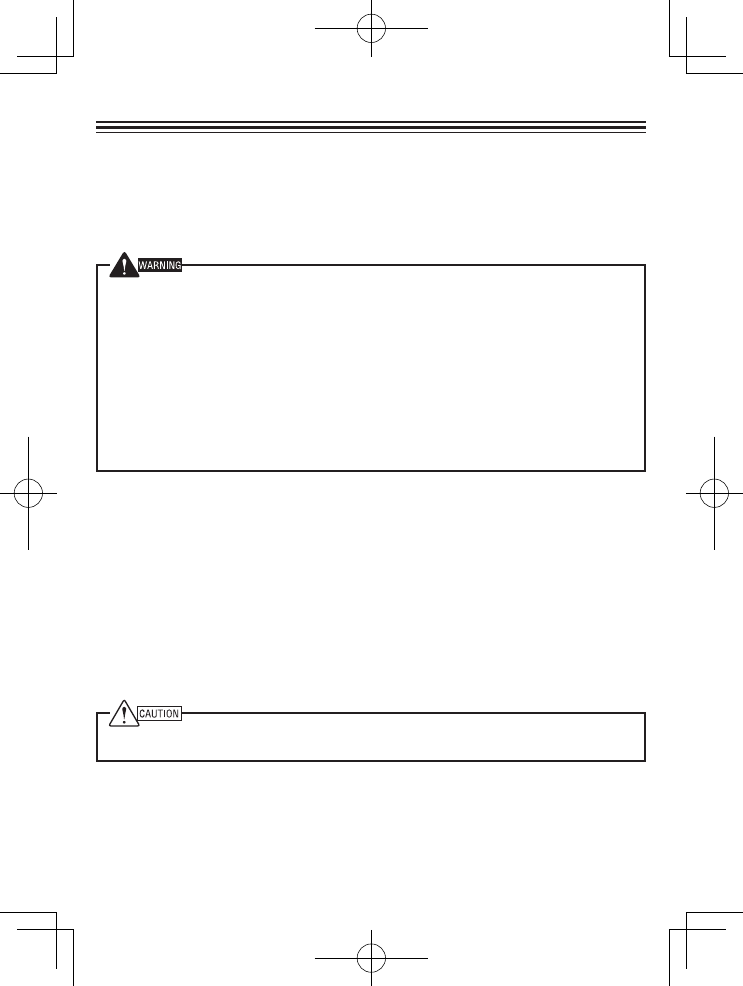
RADIO FREQUENCY ENERGY SAFETY INFORMATION
This KENWOOD transceiver has been tested and complies with the standards listed below, in regards
to Radio Frequency (RF) energy and electromagnetic energy (EME) generated by the transceiver.
• FCC RF exposure limits for
Occupational Use Only
. RF Exposure limits adopted by the FCC are generally
based on recommendations from the National Council on Radiation Protection and Measurements, & the
American National Standards Institute.
• FCC OET Bulletin 65 Edition 97-01 Supplement C
• American National Standards Institute (C95.1 – 1992)
• American National Standards Institute (C95.3 – 1992)
This KENWOOD transceiver generates RF EME while transmitting. RF EME (Radio Frequency Electric &
Magnetic Energy) has the potential to cause slight thermal, or heating effects to any part of your body less
than the recommended distance from this radio transmitter’s antenna. RF energy exposure is determined
primarily by the distance to and the power of the transmitting device. In general, RF exposure is minimized
when the lowest possible power is used or transmission time is kept to the minimum required for consistent
communications, and the greatest distance possible from the antenna to the body is maintained. The
transceiver has been designed for and is classified for
Occupational Use Only
. Occupational/ controlled
exposure limits are applicable to situations in which persons are exposed to RF energy as a consequence
of their employment, and such persons have been made aware of the potential for exposure and can
exercise control over their exposure. This means you can use the transceiver only if you are aware of
the potential hazards of operating a transceiver and are familiar in ways to minimize these hazards. This
transceiver is not intended for use by the general public in uncontrolled environments. Uncontrolled
environment exposure limits are applicable to situations in which the general public may be exposed to RF
energy, or in which the persons who are exposed as a consequence of their employment may not be fully
aware of the potential for exposure or cannot exercise control over their exposure.
The following list provides you with the information required to ensure that you are aware of RF
exposure and of how to operate this transceiver so that the FCC RF exposure limitations are not
exceeded.
• While transmitting (holding the PTT switch or speaking with VOX enabled), always keep the antenna
and the radio at least 3 cm (1 3/16 inches) from your body or face, as well as from any bystanders. A
LED on the top of the radio shows red when the transmitter is operating in both PTT and VOX modes.
• Do not transmit for more than 50% of the total transceiver use time; transmitting over 50% of the total use
time may exceed the limits in accordance to the FCC RF exposure requirements. Nominal transceiver
operation is 5% transmission time, 5% reception time, and 90% stand-by time.
• Use only the specified antenna for this transceiver; this may be either the antenna provided with the
transceiver or another antenna authorized by KENWOOD.
Use only KENWOOD authorized accessories (antennas, battery packs, belt clips, Speaker/ Mics
or headsets etc.): When worn on the body, always place the radio in a KENWOOD recommended
clip or carrying case meant for this product. The use of other than recommended or approved
body- worn accessories may result in RF exposure levels which exceed the FCC’s occupational/
controlled environment RF exposure limits.
To ensure that your exposure to RF EME is within the FCC limits for occupational use, you must
observe and adhere to the above points.
Electromagnetic Interference Compatibility
Electronic devices are susceptible to electromagnetic interference (EMI) if they are not adequately
shielded or designed for electromagnetic compatibility. Because this transceiver generates RF
energy, it can cause interference to such equipment.
• Turn OFF your transceiver where signs are posted to do so. Hospitals and health care facilities use
equipment that is sensitive to electromagnetic radiation.
• Turn OFF your transceiver while on board an aircraft when so instructed. Use of the transceiver must
be in accordance with airline regulations and/or crew instructions. B59-2687-00